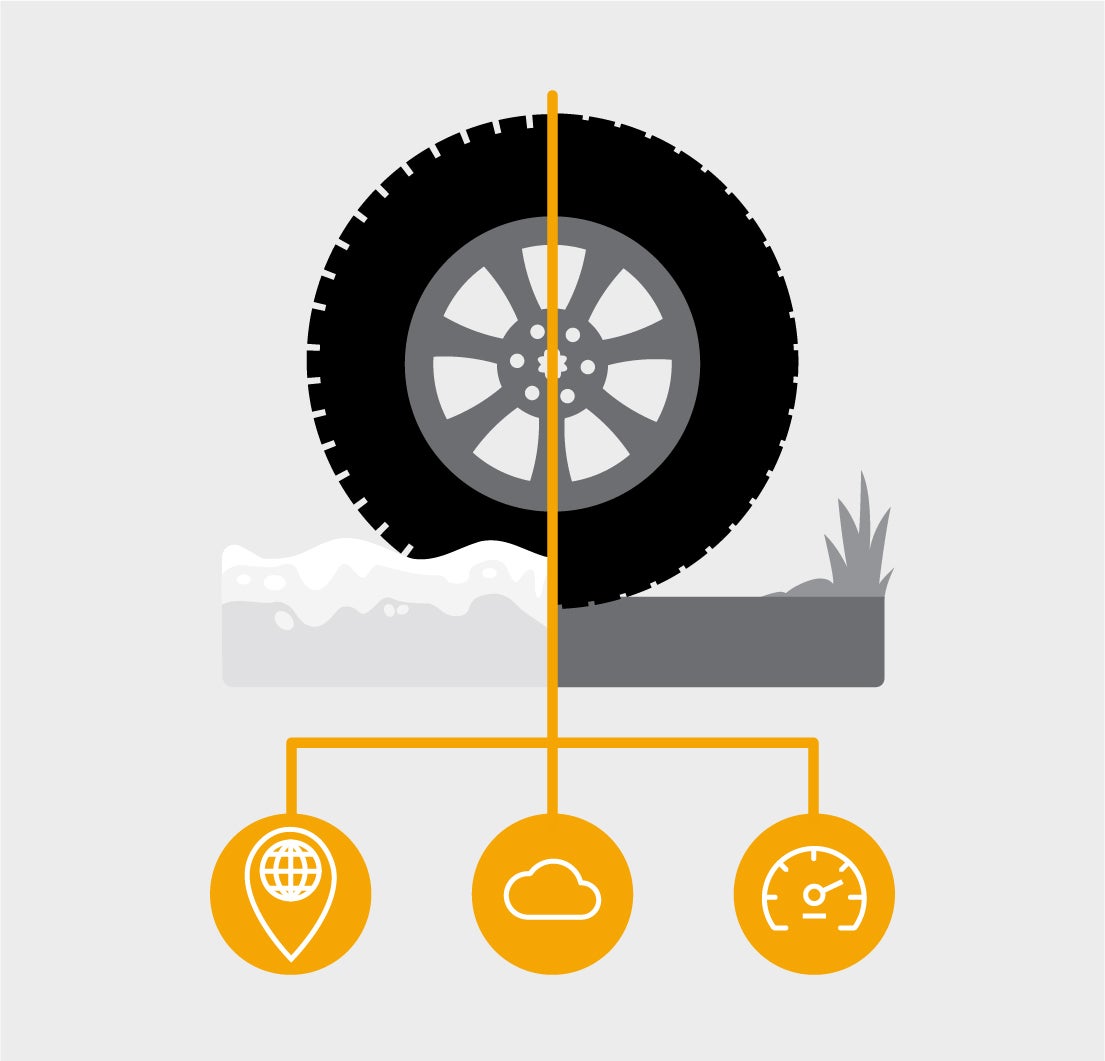
# Winter World
Tread on winter tyres
What you need to know about tread on winter tyres
If you were to look at tyre track markings left in dirt, the distinctive patterns may remind you of a shoe print. And, just like comparing the prints left by winter boots and summer shoes, you can work out which are snow tyres, and which are summer tyres. Along with other tyre features, the unique patterns designed for winter tyres influence your vehicle’s traction, grip and brake performance – especially on ice, wet surfaces and in snow. In this article we’ll investigate why tyre patterns are so distinct and why tread is especially important for winter tyres.
Elements that make every tyre unique
In harsh winter conditions, a tyre's tread pattern enhances a vehicle’s grip and handling on icy roads. It is formed from four main divisions:
- Tread blocks, raised rubber sections that have direct contact with the road and which eventually wear down over time.
- Sipes, very thin slots cut into the tread block. They provide extra traction in wet weather, snow and ice.
- Grooves, continuous ruts that run around the circumference of the tyre to effectively channel away water. They are deeper in snow tyres to help reduce the chances of aquaplaning and generally create more traction.
- Ribs, the raised rubber sections that run around the circumference of the tyre to help improve steering in snow, on ice covered surfaces and wet roads.
While these four main divisions help form a tyre's pattern, there’s a fifth element that makes all the difference for winter tyres – the tyre compound. Winter and all-season tyres are made from a specially formulated natural rubber compound that is softer and more flexible than summer tyres. It means that they’re able to offer much better grip and traction in lower temperatures. The winter tyre tread design offers its benefits especially on roads covered with snow or mud. The snow gets pressed into the wider and deeper tread grooves and by this it utilises the effect of shear forces on snow for additional grip. The wider grooves can also absorb more slush contrary to summer tyres and ensure more contact to the road surface.
You can learn more about the differences between summer and winter tyres here. Overall, these 5 elements work together by interlocking and biting into snow and ice to provide additional traction and improved braking.
How is the tread different on snow tyres?
As mentioned above, winter tyre patterns have larger, deeper grooves and additional thin channels known as sipes. This combination allows greater brake control, traction and safety when driving in snow or icy and muddy road surfaces. Additionally, when snow gets compacted into the deep grooves, this helps create further traction.
Watch out for tread depth on winter tyres
The performance of an all-season or winter tyre depends largely on the tread depth. As tyre tread wears down over time, its ability to maintain grip on frosted roads reduces. To ensure optimum driving performance and more importantly driving safety, your tyres should always have sufficient tread. Always consider the legal regulations of your country and take into account that tyre performance decreases with tread depth, especially in winter conditions.
 Tread depth for winter tyres
Tread depth for winter tyres
How to check tread depth
You should aim to check you tire tread depth at least every two weeks, along with your tyre pressure. You can do this is two different ways:
Use a tread depth gauge, inserting the probe into the groove and pushing the shoulders down to the surface of the tyre. Do this across several sections of the tyre and ensure the tread depth meets the legal requirements in the country you are driving in. If it's below this measurement, it's time for new winter tyres. In a pinch, you can also use a small ruler to check your tread.
Check your tread wear indicators, sometimes referred to as wear bars. All tyres are manufactured with a series of small rubber bars embedded in a section of the tyre grooves. Once the tread is worn down, these bars are flush with the level of the tread pattern. This means the tyre has reached its limit of winter suitability and it is now time for new tyres. Note: you may need to rotate your tyre a few times to find the wear bars.

Watch out for damage on your winter tyres
When checking your winter tyre tread, look for any damage such as unusual bulges, small scoops and divots in the tyre. They could indicate that your tyres are misaligned or that there may be other problems with your vehicle. If you do find any damage, visit your local tyre specialist as soon as possible for a thorough check. You should also closely check the conditions of your winter tyres when you prepare your vehicle for the cold season.
Related content
-
 2022/09/07Winter vs. all-season tyresWhat’s the difference between winter and all-season tyres? Learning the design considerations behind tyre types can help decide which ones you need.Read more
2022/09/07Winter vs. all-season tyresWhat’s the difference between winter and all-season tyres? Learning the design considerations behind tyre types can help decide which ones you need.Read more -
 2022/09/07Winter tyre lawsLearn when you need to switch to winter tyres and whether they're compulsory in your region.Read more
2022/09/07Winter tyre lawsLearn when you need to switch to winter tyres and whether they're compulsory in your region.Read more -
 2022/09/07Testing winter tyresEver wondered how we test winter tyres? Learn more about every step of the tyre testing process.Read more
2022/09/07Testing winter tyresEver wondered how we test winter tyres? Learn more about every step of the tyre testing process.Read more